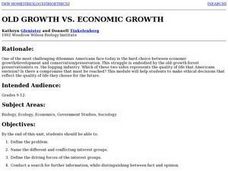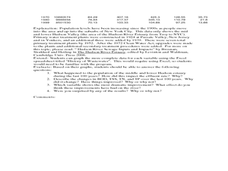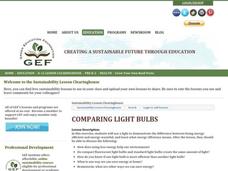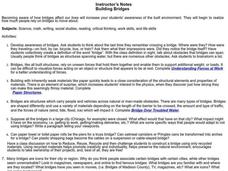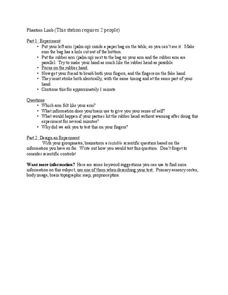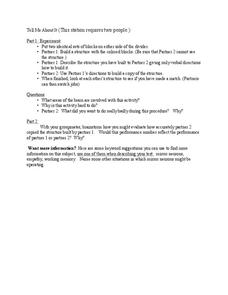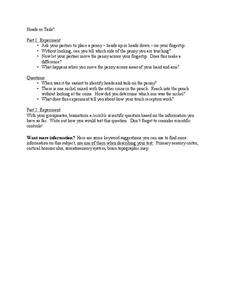Curated OER
Prehistoric Pen Pals
Students read online information and identify relevant information about a particular dinosaur species, assume the personality of a specific dinosaur species, and write online "getting to know you" letters to other student-dinosaurs in...
Curated OER
Conservation vs. Economic Growth
Investigate the choices people make between economic growth and personal growth and development using the ethical/decision making model. Small groups create and present a position paper describing their feeling for or against the...
Curated OER
Historical Pollution in the Hudson: Part 2
Ninth graders practice how to format and enter data into an Excel spreadsheet, make a graph, and interpret graphed data. They recognize how the pollution in the Hudson River has changed over time, and explain the consequences of these...
Curated OER
Reclamation Mountain
Students observe the effects of mining on a mountain. In this environmental awareness lesson, students will be challenged to extract items from a model of a mountain without disturbing the vegetation on the mountain. Students will come...
Curated OER
Building A Solar Still
Students investigate the water cycle by viewing an online video. In this drinking water lesson, students create solar stills at their campus in order to purify water that is tainted. Students view a video on their computers about...
Curated OER
School Forest
Sixth graders explore the concept of biodiversity. In this biodiversity lesson, 6th graders discover a variety of planets and animals that live in forests, and how a rotting log benefits that environment. Students also locate seven...
Curated OER
Sustainable Marine Fisheries
Through a fishing simulation, environmentalists discover consequences of over fishing. Afterward, they discuss how the activity relates to the impact of real-life commercial fishing. They also consider sustainability in the fishing...
Curated OER
Role Models
First graders identify heroes by researching their family history. In this personal heritage lesson, 1st graders define the term "hero" and the characteristics that represent it. Students research family resources and family trees in...
Curated OER
Comparing Light Bulbs
Third graders learn how light bulbs are different and which are more cost efficient. In this energy and efficiency lesson, 3rd graders compare the cost of a light bulb and understand that its lifetime is important to their choice.
Curated OER
Building Bridges
Provide a comprehensive exploration of bridges and civil engineering. First, learners discuss the different types of bridges. Then, they identify the characteristics of a suspension, beam, and arch type of bridge. In addition, they learn...
Curated OER
Pavement or Dirt?
What are the pros and cons to having either permeable or impermeable materials for building? How do they affect the environment? Use this role-play and the extension activities to get your environmental scientists thinking about the...
University of Wisconsin
Getting the Word Out
An appropriate way to celebrate and conclude the construction of a rain garden is to share it with the community. Small groups collaborate to design an outreach product such as a PowerPoint presentation, brochure, or poster, to draw...
California Academy of Science
What Would Happen?
Nothing says classroom fun like an invertebrate and a magnifying glass! Snails, earthworms, and roly-poly bugs become the center of attention as pint-sized investigators hone their inquiry and observation skills. They are guided through...
Odyssey of the Mind
Odyssey of the Mind Curriculum Activity: From a Distance
Challenge your class with an amazing set of ideas that really put the project back into project-based learning. It all starts with a whole class research task. Each learner will look up and take notes on multiple facets of things that...
NASA
Geographical Influences
"If global warming is real, why is it so cold?" Distinguishing the difference between weather and climate is important when it comes to understanding our planet. In these activities, young scientists look at the climate patterns in a...
Texas State Energy Conservation Office
Investigation: Concept Mapping Fuels
After reading an article, "Fuels for Everything," collaborative groups create a concept map poster of the transportation and non-transportation fuels. This makes a strong introduction to the different types of fuels used for transportion...
Chicago Botanic Garden
Climate Change Around the World
Look at climate change around the world using graphical representations and a hands-on learning simulation specified to particular cities around the world. Using an interactive website, young scientists follow the provided directions to...
University of Minnesota
Phantom Limb
A phantom of neuroscience may leave pupils perplexed as they engage in an experimental lesson that recreates a phantom limb scenario. After experiencing the phenomenon, they choose a scientific question to explore further.
Scholastic
STEM Challenges and Activity Sheets 3–5
How can engineers help their communities? Three challenges in the first unit explore why STEM is important to communities and how neighborhoods are engineered to experience those benefits. The second unit prompts groups to plan an...
University of Minnesota
Tell Me About It
Have you ever tried following confusing or incomplete directions? In a hands-on experiment, partners give and follow directions to build a structure. Scholars apply their years of experience taking instructions to prove they know the...
University of Minnesota
Get the Point(s)
Do all areas of your skin have the same sensitivity to touch? Playing with the sense of touch, this experiment has scholars guessing how many pin heads gently touch their arm and hand. In the second part, pupils answer questions about...
University of Minnesota
Heads or Tails
How exactly does touch help us identify items? Students test this question by feeling a coin without moving their fingers and trying to determine if it is heads or tails. They test their accuracy by rubbing their fingers on the coins....
PBS
Kinetic Sculpture
Build a sculpture that moves on its own; no power source required! The second installment of a five-part series has individuals create a sculpture that moves with the wind. It can't topple over though, so some type of support is necessary.
Curated OER
Creature Feature Poetry Keyword Search!
Young scholars examine the differences between fact and opinion, and brainstorm ideas for a keyword list by analyzing facts. They listen to poems, and create posters listing three keywords about each creature featured in the poetry.



